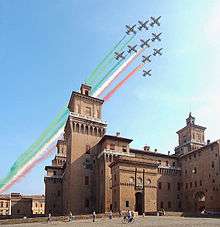National colours of Italy
The national colours of Italy are green, white, and red,[1] collectively known in Italian as il tricolore (the tricolour). The three Italian national colours appeared for the first time in Genoa on 21 August 1789 on the cockade of Italy shortly after the outbreak of the French Revolution.[2] Green, white and red are also national colours of Bulgaria, Hungary, Iran, Lebanon and Mexico.
In sport in Italy, savoy azure has been used or adopted as the colour for many national teams, the first being the men's football team in 1910. The national auto racing colour of Italy is instead rosso corsa ("racing red"), while in other disciplines such as cycling and winter sports, white is often used.
History
The hypotheses rejected by historians
.jpg)
Often in historical research aimed at studying the origin of the Italian tricolour we have considered the hypothesis that green, white and red have been used as national colours since medieval times, thus wanting to trace the creation of the Italian tricolour to remote epochs: in reality these conjectures on the origin of the colours, which would link the presumed medieval tricolour to that born in the Napoleonic era, are historically to be rejected, given the total absence of sources that prove this link.[3]
In the Middle Ages the three colours were forcibly recognized in some events of history of Italy, such as on the flagpole of the Carroccio during the battle of Legnano, on the banners of the Tuscan Guelphs, whose coat of arms was formed by a red eagle on a white field above a green snake, blazon that was granted by Pope Clement IV,[4] on the sign of the Sienese contrada of the Goose, on the tricolour uniforms of the servants of the Duchess of Milan Valentina Visconti; in Renaissance times the Italian national colours were imagined on the carpets that welcomed Renée of France, who then married Ercole I d'Este, upon her arrival in Ferrara, on the tricolour uniforms of the Borso d'Este army and on the green flag , white and red that began to enshrine from the Cathedral of Milan on the occasion of the entry into the Milanese capital of Francis I of France after his victory in the battle of Marignano.[3][5][6]
Other scholars have suggested the prefiguration of the Italian tricolour in pictorial works; in fact the clothes of some characters painted on the walls of Palazzo Schifanoia in Ferrara, which date back to the Middle Ages, are green, white and red.[7] Also these hypotheses, based this time on artistic representations, are to be discarded because they are not based on historical findings.[7] The reason for the historical inconsistency of the hypothetical presence of the tricolour in historical events and artistic works prior to the modern era lies in the fact that at the time the Italian national awareness, which appeared centuries later, had not yet occurred.[8]
The three colours of the Italian flag are cited, in literature, in some verses of canto XXX of the Purgatorio in the Divine Comedy, and this has fueled theories that would like the birth of the tricolour connected to Dante Alighieri: they too are considered groundless by scholars,[9] as Dante in these verses he did not think of a politically united Italy, but of the theological virtues, or rather of charity, hope and faith, with the last two being metaphorically symbolized in the Italian flag.[10]
Origins of the Italian tricolour
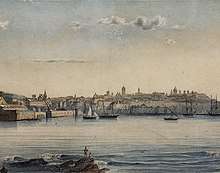
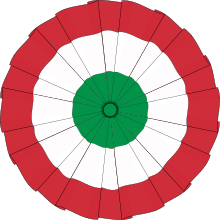
The tricolore was symbolically important preceding and throughout the Risorgimento leading to Italian unification.
The first documented trace of the use of Italian national colours is dated 21 August 1789: in the historical archives of the Republic of Genoa it is reported that eyewitnesses had seen some demonstrators pinned on their clothes hanging a red, white and green cockade on their clothes.[2] The Italian gazettes of the time had in fact created confusion about the facts of French revolution, especially on the replacement of green with blue, reporting the news that the French tricolour was green, white and red.[11] The green was then maintained by the Italian Jacobins because it represented nature and therefore - metaphorically - also natural rights, or social equality and freedom.[12]
In September 1794, Luigi Zamboni and Giambattista de Rolandis created a cockade by uniting the white and red of the flag of Bologna with green, a symbol of liberty and hope that the populace of Italy join the revolution begun in Bologna to oust the foreign occupying forces.[13][14] This tricolore was considered a symbol of redemption that from its creation was "consecrated to immortality of the triumph of faith, virtue, and sacrifice" of those who created it.[15]
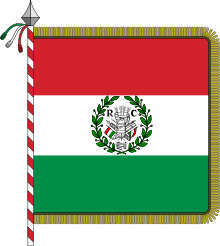
Napoleon Bonaparte, in a letter from Milan to an executive director on 11 October 1796, stated that the Legione Lombarda had chosen these colours as the national colours.[16] In a solemn ceremony at the Piazza del Duomo on 16 November 1796, a military flag was presented to the Legione Lombarda, which would become a unit in the Cisalpine Republic (1797–1802) military, and was the first tricolore military standard to fly at the head of an Italian military unit.[17][18] The first official Italian flag of an Italian sovereign state was created for the Cispadane Republic (1796–1797) in Reggio Emilia on 7 January 1797 based on a proposal by government deputy Giuseppe Compagnoni.[19][14]
The formation of the Cisalpine Republic was decreed by Napoleon on 29 June 1797, and consisted of most of the Cispadane Republic and Transpadane Republic (1796–1797), which included between them Milan, Mantua, the portion of Parma north of the Po river, Bologna, Ferrara, and Romagna, and later the Venetian Republic.[20] Its flag was proclaimed to be the tricolore, representing the "red and white of Bologna and the green of liberty".[21]
Young Italy, a political movement founded in 1831 by Giuseppe Mazzini calling for a national revolution to unify all Italian-speaking provinces, used a "theatrical" uniform based on the national colours.[22] These colours had been in use in the Cispadane Republic, Transpadane Republic, Cisalpine Republic, Italian Republic (1802–1805), and the Kingdom of Italy (1805–1814), precursors to the modern state. During the formation of the Roman Empire of 1814, the foundational constitutional basis specified that the three national colours would be preserved.[23]
Politics
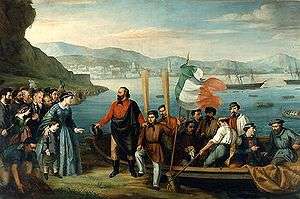
The colours have been used for political purposes.
During his visit to London on 11 April 1864, Giuseppe Garibaldi was greeted by a throng of people at the train station, many of whom carried Italian flags.[24] English men dressed in red shirts commonly worn by Garibaldi's followers during his Mille expedition to southern Italy, and women dressed in the national colours of Italy.[24] Italian flags could be seen throughout the city.[24] In 1848, Garibaldi's legion dressed in red shirts with green and white facing.[25]
In 1868, two years after the Austrians departed Venice following the Third Italian War of Independence, the remains of statesman Daniele Manin were brought to his native city and honoured with a public funeral.[26] He had been acclaimed president of the Venetian Republic of San Marco by residents of Venice after a revolt in 1848.[27][28] The gondola carrying his coffin was decorated with bow "surmounted by the lion of Saint Mark, resplendent with gold", bore "the Venetian standard veiled with black crape", and had "two silver colossal statues waving the national colours of Italy".[29] The statues represented the unification of Italy and Venice.[30] The funeral procession was described as "magnificent".[30] His remains are interred at the Basilica of Santa Croce, the first person buried there in over 300 years.[26]
An apocryphal story about the history of pizza holds that on 11 June 1889, Neapolitan pizzamaker Raffaele Esposito created a pizza to honour Margherita of Savoy, who was visiting the city. It was garnished with tomatoes, mozzarella, and basil to represent the national colours of Italy, and was named "Pizza Margherita".[31][32][33]
Definition

The need to precisely define the colours was born from an event that happened at the Justus Lipsius building, seat of the Council of the European Union, of the European Council and of their Secretariat, when an Italian MEP, in 2002, noticed that the colours of the Italian flag were unrecognizable with red, for example, which had a shade that turned towards orange: for this reason the government, following the report of this MEP, decided to specifically define the colours of the Italian national flag.[34]
In 2003, the government of Italy specified the colours using Pantone. The new specification was demonstrated on sample flags displayed at Palazzo Montecitorio; they had a darker tint than the traditional colours, described as having a deeper green, a red with "ruby hues", and ivory or cream instead of white.[35][36] Government officials stated that the sample flags did not conform to the "specified chromatic specification".[37]
The values were revised after discussion, and in 2006 were decreed by law in Article 31 of Disposizioni generali in materia di cerimoniale e di precedenza tra le cariche pubbliche ("General provisions relating to ceremonial materials and precedence for public office", published 28 July 2006 in Gazzetta Ufficiale) for polyester fabric bunting to use the following Pantone Textile Colour System values:[38][39]
Description Number RGB CMYK HSV Hex Fern Green 17-6153 TC (0, 140, 69) (100%, 0%, 51%, 45%) (150°, 100%, 55%) #008C45 Bright White 11-0601 TC (244, 245, 240) (0%, 0%, 2%, 4%) (72°, 2%, 96%) #F4F5F0 Flame Scarlet 18-1662 TC (205, 33, 42) (0%, 84%, 80%, 20%) (357°, 84%, 80%) #CD212A
Use
Institutions
The national colours are specified in the Constitution of Italy to be used on the Flag of Italy, a vertical tricolour flag of green, white, and red.[40][41] It is also used on the cockade, another of the national symbols of Italy. Its use of the national colours was the antecedent for its use in the flag.[42][43][44]
The Presidential Standard of Italy is the flag used by the President of the Italian Republic, the nation's head of state. It is based on the square flag of the Napoleonic Italian Republic, on a field of blue charged with the coat of arms of Italy in gold.[45]
On 31 December 1996, legislation was passed (legge no. 671) instituting 7 January as national flag day, known as Festa del Tricolore, and was published in the Gazzetta Ufficiale della Repubblica Italiana three days later.[46] Its purpose was to celebrate the bicentennial of the establishment of the Italian flag on 7 January 1797.[14] The most important of these celebrations is that at the Sala del Tricolore ("Room of the tricolour") in the commune palace of Reggio Emilia, and a solemn changing of the guard at the Quirinal Palace in Rome, followed by a parade of the Corazzieri and a brass band fanfare by the Carabinieri Cavalry Regiment.[14]
The Frecce Tricolori, the aerobatics demonstration team of the Italian Aeronautica Militare based at Rivolto Air Force Base, are so named for the green, white, and red smoke trails emitted during performances, representing the national colours.[47][48]
Sport

In football, the winners of Serie A are the Italian football champions, which entitles the winning team to adorn the jersey of each of its players with the scudetto, an escutcheon (heater shield) of the Italian flag, the subsequent season.[49]
The practice was established in 1924 (first ever team to wear it was Genoa C.F.C.), after Gabriele D'Annunzio had wanted to put a shield flag on the uniforms of Italian military commanders during a friendly match.[49] Since then, the scudetto has become the symbol of the defending champions of every sports league in Italy.
The league operators state that it is "representative of national unity at the level of football".[50] The winner of the Coppa Italia is entitled to adorn its team jersey with a tricolour cockade for the subsequent season.[51]
Tributes
The name of Italia Peak, a peak in the Elk Mountains of Colorado in the United States, is derived from the display on one of its faces, when seen at a distance, of "brilliant red, white and green colours, the national colours of Italy".[52][53][54]
Meaning of colours
Multiple hypotheses attempt to explain the metaphorical and allegorical meanings related to the Italian national colours, when green, white and red became uniquely characteristic as the Italian patriotic symbol.[55] In particular, the Italian tricolore adapted from the French tricolour of blue (fraternity), white (equality) and red (liberty; also, white symbolized the monarchy, while red and blue were the ancient Coat of arms of Paris[55]).
The oldest association of metaphorical meanings to the future Italian tricolour is ascribable to 1782, when the Milanese citizen Militia was founded, whose uniforms consisted of a green dress with red and white insignia; for this reason, in the Milanese dialect, the members of this municipal guard were popularly called remolazzit, or "small radishes", recalling the lush green leaves of this vegetable.[56] Even white and red were common on Lombard military uniforms of the time:[57][56][58] the two colours are characteristic of the coat of arms of Milan.[59]
It was therefore no coincidence that the first war flag in green, white and red, already considered "Italian", debuted on 11 October 1796 on the Lombard Legion's war banner: the three colours were already in the collective imagination of Lombard for historical reasons.[58]
During the Napoleonic period, which lasted from 1796 to 1815, the three Italian national colours gradually acquired an increasingly idealistic meaning, which over time became widespread among the population, disengaging from the original historical meanings linked to the birth of the three colours: the green has begun to represent hope, white is faith and red is love.[56][60]
The green of the Italian tricolour was the only one to have, from its origins, an idealistic meaning: it symbolized for the Jacobins the natural rights, that is social equality and freedom.[12]
Hypotheses considered unreliable, and therefore rejected by historians, are the alleged metaphorical references to the tricolour contained in the Divine Comedy by Dante Alighieri, in which the theological virtues, that is charity, hope and faith, with the last two which were then symbolized, without historical bases, in the Italian flag.[10] This hypothesis would therefore like the interpretation of Italian national colours linked to religious meanings,[61] particularly with regard to Catholicism, a religion which has always been the majority religion in Italy.[62]
Another hypothesis that attempts to explain the meaning of the three Italian national colours would like, also without any historical basis, that the green is linked to the colour of the meadows and the Mediterranean maquis, the white to the snow of the Alps and the red to the spilled blood by Italian soldiers in the Wars of Italian Independence and Unification.[61][63]
For the adoption of greenery there is also the so-called "Freemasonry hypothesis": for this initiatory society green was the colour of nature, so much a symbol of human rights, which are naturally inherent in man,[57] as well as of flourishing Italian landscape; this interpretation, however, is opposed by those who maintain that Freemasonry, as a secret society, did not have such an influence at the time as to inspire Italian national colours.[64]
Another implausible conjecture that would explain the adoption of the green hypothesizes a tribute that Napoleon wanted to give to Corsica, a place where.[56] Still another hypothesis, even in this case totally unfounded, would like the tricolour to derive from the main colours of the Margherita pizza, so named in honor of Queen Margherita of Savoy, whose main ingredients should recall the three Italian national tones, namely the green for the basil, white for mozzarella and red for tomato sauce:[65] this assumption is completely senseless, given that the invention of the pizza Margherita dates back to 1889,[66] while the Italian national colours first appeared a hundred years before, in 1789 in Genoa.[2]
Other Italian national colours
Azure
With the unification of Italy, and with the consequent extension of the Albertine Statute to the whole Italian peninsula, to the green, to the white and to the red, a fourth national colour was added, the Savoy blue, a distinctive chromatic tonality of the Italian ruling family, the House of Savoy; in particular, in the institutional sphere, it was included in the flag of the Kingdom of Italy on the contour of the royal coat of arms to prevent the cross and the field of the shield from being confused with the white and with the red of the banner.[58]
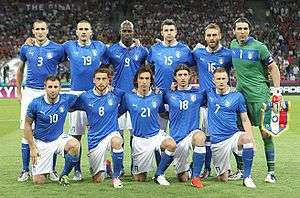
The origin of the colour is dated 20 June 1366, when Amadeus VI, Count of Savoy, about to leave for a crusade called by Pope Urban V which was intended to help the Byzantine emperor John V Palaiologos, cousin of the maternal part of the Savoy Count, decided to place on the flagship of the fleet, a galley of Republic of Venice, a blue flag that fluttered next to the red-crusading silver banner of the Savoys.[67]
The colour therefore has a Marian implication, bearing in mind that there is also the possibility that the use of a blue banner by the Savoys started earlier.[68]
.jpg)
The Savoy blue has been preserved in some institutional contexts even after the birth of the Italian Republic: in fact this is the edge of the Presidential Standard of Italy (blue, in heraldry, means "law" and "command") and is the dominant colour of the institutional flags of some important public offices (President of the Council of Ministers of the Italian Republic, Minister and Undersecretaries of Defense, high military ranks Navy and Air Force). The Savoy blue border on Presidential Standard of Italy symbolize the four Italian armed forces, namely the Italian Air Force, the Carabinieri, the Italian Army and the Italian Navy, of which the President is the commander.[69]
The blue shade of the Savoy blue colour, already in use on military cockades, on the ties of the flags and on the bands of the Savoy officers, still continues to appear as one of Italy's reference and recognition colours, so much so that it has become the shade used on the Italian national sports shirts, on the blue scarf supplied to the officers of the Italian armed forces, on the distinctive band of the presidents of the Italian provinces[70][71] and on the aircraft used by the Frecce Tricolori, also traditions that have never stopped even on the occasion of the birth of the Italian Republic.[72]
After having played its first two international matches in white in 1910, the men's football team announced its new uniform on 31 December 1910, an azure shirt with an escutcheon of the Italian colours, and white shorts.[73] The blue shirt was first worn on 6 January 1911 in a match against Hungary in Milan.[74] Even this case, the blue has been maintained despite the abolition of the Italian monarchy.[75]
In sport, many men's national teams are known as the azzurri and women's teams as the azzurre (meaning "azure"). These include the men's basketball,[76] men's football, men's ice hockey, men's rugby league, men's rugby union, and men's volleyball[77] teams, and the women's basketball,[78] women's football, women's ice hockey, and women's volleyball[79] teams.
Rosso corsa

The national auto racing colour of Italy is rosso corsa ("racing red").[80] Since the 1920s Italian race cars of Alfa Romeo, Maserati, Lancia, and later Ferrari and Abarth have been painted in rosso corsa ("racing red"). This was the customary national racing colour of Italy as recommended between the world wars by the organisations that later became the FIA. In that scheme of international auto racing colours French cars were blue (Bleu de France), British cars were green (British racing green), etc.
In Formula One, the colour was not determined by the country the car was made in nor by the nationality of the driver(s) but by the nationality of the team entering the vehicle. National colours were mostly replaced in Formula One by commercial sponsor liveries in 1968, but unlike most other teams, Ferrari always kept the traditional red but the shade of the colour varies.
Red cars are also traditional in Alfa Romeo and Ferrari car running in other motorsport championships, such as Supertouring championships in the former and the 24 Hours of Le Mans and 24 Hours of Daytona in the latter. In contrast, since the 2000s Maserati has been using white and blue and Abarth has been using white with red flashes. Rosso Corsa is also an extremely popular colour choice for Ferrari road cars, nearly 80% of all Ferraris sold are in the colour.
White
In sports such as cycling and winter sports, the jerseys of the Italian athletes are often white.
Notes
- Ferorelli 1925, p. 654-680.
- Ferorelli, Nicola (1925). "La vera origine del tricolore italiano". Rassegna Storica del Risorgimento (in Italian). XII (fasc. III): 662.
- Fiorini, 1897 & pp. 244-247.
- The red eagle on a white field above a green snake was also the emblem of Pope Clement IV.
- Fiorini, 1897 & pp. 265-266.
- Colangeli, 1965 & p. 10.
- Fiorini, 1897 & p. 246.
- Ferorelli, Nicola (1925). "La vera origine del tricolore italiano". Rassegna Storica del Risorgimento (in Italian). XII (fasc. III): 668.
- Bovio, 1996 & p. 23.
- Pagano, 1895 & p. 10.
- Ferorelli, Nicola (1925). "La vera origine del tricolore italiano". Rassegna Storica del Risorgimento (in Italian). XII (fasc. III): 666.
- "I valori - Il Tricolore" (in Italian). Retrieved 3 May 2017.
- Venosta 1864, p. 30-32Noi al bianco ed al rosso, colori della nostra Bologna, uniamo il verde, in segno della speranza che tutto il popolo italiano segua la rivoluzione nazionale da noi iniziata, che cancelli que' confini segnati dalla tirannide forestiera.
- La Repubblica 2013.
- Venosta 1864, p. 32.
- Bonaparte 1822, p. 238Vous y trouverez l'organisation de la légion lombarde. Les couleurs nationales qu'ils ont adoptées sont le vert, le blanc et le rouge.
- Frasca 2001, p. 49.
- Canella 2009, p. 130.
- Italian Ministry of Foreign Affairs.
- Partington 1836, p. 548.
- Waley & Hearder 1963, p. 118.
- Collier 2003, p. 25The national colours of Italy were worn in combination with a green blouse being complemented with a red belt and white trousers.
- Dippel 2009, p. 25I tre colori nazionali sono conservati.
- Oddo 1865, p. 522.
- Young & Stevens 1864, p. 64.
- Cook Thomas and son 1874, p. 29.
- Cunsolo: Venice and the Revolution of 1848–49.
- Cunsolo: Daniele Manin (1804–1857).
- Cook Thomas and son 1874, p. 29–30.
- Cook Thomas and son 1874, p. 30.
- Danford, p. 38.
- The Philadelphia Inquirer 1989, p. E08.
- Lakeland Ledger 1989, p. 12A.
- Villa, 2010 & p. 35.
- BBC: Italian opposition in flap over flag.
- Corriere della Sera 2003.
- Corriere della Sera & seraLa presidenza del Consiglio – si legge nella nota – ha verificato che le nuove bandiere tricolori esposte a Montecitorio non corrispondono ai valori cromatici indicati nella propria circolare...
- Gazzetta Ufficiale della Repubblica Italiana 2006.
- Prefettura di Pisa, p. 2.
- La Costituzione.
- Constitution of the Italian Republic.
- Biblioteca dell'Accademia virgiliana, p. 4...o Bandiera Cispadana di tre colori, verde, bianco e rosso, e che questi tre colori si usino anche nella coccarda cispadana la quale debba portarsi da tutti
- Protonotari 1897, p. 239-267 and 676–710.
- Murati 1892, p. 12–13.
- Gazzetta Ufficiale della Repubblica Italiana 2000.
- Gazzetta Ufficiale della Repubblica Italiana 1997.
- Haberman 1989.
- Wings, p. 6the Italians call themselves Frecce Tricolori (and emphasize the title by emitting red, white, and green smoke)
- Lega Nazionale Professionisti: Premiazione scudetto 2012.
- Lega Nazionale Professionisti: Premiazione scudetto & scu...uno scudetto con i colori della bandiera italiana, rappresentativo dell'unità nazionale a livello calcistico
- Lega Nazionale Professionisti:Regolamento 2012, p. 247/700 and Articolo 1, section 12.1 Società vincitrice.
- Ayer 1880, p. 211.
- Diller 1902, p. 145.
- Dana & Silliman 1874, p. 400.
- Busico, 2005 & p. 9.
- Maiorino, 2002 & p. 158.
- Villa, 2010 & p. 11.
- "Il Tricolore" (in Italian). Archived from the original on 31 March 2014. Retrieved 19 March 2016.
- "Origini della bandiera tricolore italiana" (PDF) (in Italian). Archived from the original (PDF) on 24 February 2017. Retrieved 4 October 2018.
- Villa, 2010 & p. 13.
- "Perché la bandiera italiana è verde bianca rossa" (in Italian). Retrieved 20 August 2018.
- "Bandiera italiana: storia, colori, foto e significato" (in Italian). Retrieved 20 August 2018.
- "Il significato dei tre colori della nostra Bandiera Nazionale" (in Italian). Retrieved 20 August 2018.
- Fiorini, 1897 & pp. 239-267 and 676-710.
- "Il significato dei colori della bandiera italiana: cosa rappresentano verde, bianco e rosso?" (in Italian). Retrieved 21 August 2018.
- What today is called "pizza Margherita" had however already been prepared in 1866, before the dedication to the queen of Italy, as attested by Francesco De Bourcard in: Uses and customs of Naples , reissue in anastatic copy, limited edition of 999 copies, Naples, Alberto Marotta, 1965 [1866] p.124.
- Martinelli, 2006 & p. 45.
- Martinelli, 2006 & p. 46.
- "Lo Stendardo presidenziale" (in Italian). Retrieved 4 March 2017.
- "Azzurri – origine del colore della nazionale" (in Italian). Retrieved 18 March 2016.
- Decreto legislativo 18 agosto 2000, n. 267, articolo 50, in materia di "Testo unico delle leggi sull'ordinamento degli enti locali"
- "Azzurri – origine del colore della nazionale" (in Italian). Retrieved 24 September 2019.
- Chiesa 2012, p. 44, chapter 1910–1912, Azzurri come il cieloSiamo informati che la squadra nazionale avra finalmente una sua propria divisa: una maglia di colore bleu marinaro, con sul petto uno scudo racchiudente i colori italiani
- Chiesa 2012.
- "Ecco perché la maglia della nazionale italiana è azzurra" (in Italian). Retrieved 24 September 2019.
- Federazione Italiana Pallacanestro: Gli azzurri.
- Federazione Italiana Pallavolo: Azzurri.
- Federazione Italiana Pallacanestro: Le Azzurre.
- Federazione Italiana Pallavolo: Azzurre.
- Bristow 2013, p. 7.
References
- Ayer, I. Winslow (1880). Life in the Wilds of America. Central Publishing Company.CS1 maint: ref=harv (link)
- Bonaparte, Napoléon (1822). Panckoucke, C. L. F. (ed.). Oeuvres de Napoléon Bonaparte. 1. Paris.CS1 maint: ref=harv (link)
- Bovio, Oreste (1996). Due secoli di tricolore (in Italian). Ufficio storico dello Stato Maggiore dell'Esercito. SBN IT\ICCU\BVE\0116837.
- Bristow, Grahame (2013). Restoring Sprites and Midgets. M-Y Books Distribution. ISBN 9781783180189.CS1 maint: ref=harv (link)
- Canella, Maria, ed. (2009). Dalla Repubblica Cisalpina al Regno d'Italia (1797–1814): Ricerche e strumenti. Armi e nazione. FrancoAngeli. ISBN 978-8856809985.CS1 maint: ref=harv (link)
- Busico, Augusta (2005). Il tricolore: il simbolo la storia (in Italian). Presidenza del Consiglio dei Ministri, Dipartimento per l'informazione e l'editoria. SBN IT\ICCU\UBO\2771748.
- Chiesa, Carlo (2012). La grande storia del calcio italiano. Bologna: Guerin Sportivo.CS1 maint: ref=harv (link)
- Collier, Martin (2003). Italian Unification, 1820–71. Heinemann advanced history. Heinemann. ISBN 0435327542.CS1 maint: ref=harv (link)
- Colangeli, Oronzo (1965). Simboli e bandiere nella storia del Risorgimento italiano (PDF) (in Italian). Patron. SBN IT\ICCU\SBL\0395583.
- Cunsolo, Ronald S. "Daniele Manin (1804–1857) Daniele Manin (1804–1857)". Encyclopedia of Revolutions of 1848. Ohio University.
- Cunsolo, Ronald S. "Venice and the Revolution of 1848–49". Encyclopedia of Revolutions of 1848. Ohio University.
- Dana, James D.; Silliman, B., eds. (July–December 1874). "Miscellaneous Scientific Intelligence". The American Journal of Science and Arts. S. Converse. 8 (43–48).CS1 maint: ref=harv (link)
- Danford, Natalie (October 1994). "Beyond Pizza". Vegetarian Times. Active Interest Media (109). ISSN 0164-8497.CS1 maint: ref=harv (link)
- Diller, Joseph Silas (1902). "Topographic Development of the Klamath Mountains". U.S. Geological Survey Bulletin. U.S. Government Printing Office (196).CS1 maint: ref=harv (link)
- Dippel, Hosrt, ed. (2009). Constitutions of the World from the late 18th Century to the Middle of the 19th Century. National Constitutions. 10. Walter de Gruyter. ISBN 9783598357343.CS1 maint: ref=harv (link)
- Ferorelli, Nicola (1925). La vera origine del tricolore italiano. Rassegna storica del Risorgimento. 12.CS1 maint: ref=harv (link)
- Fiorini, Vittorio (1897). "Le origini del tricolore italiano". Nuova Antologia di Scienze Lettere e Arti (in Italian). LXVII (fourth series): 239–267 and 676–710. SBN IT\ICCU\UBO\3928254.
- Frasca, Francesco (2001). "L'esercito del primo tricolore" (PDF). Informazioni della Difesa. Stato Maggiore della Difesa (6): 49–53.CS1 maint: ref=harv (link)
- Haberman, Clyde (27 September 1989). "Ravenna Journal; After the Unthinkable, the Sky Show Must Go On". The New York Times. Retrieved 23 November 2013.CS1 maint: ref=harv (link)
- Maiorino, Tarquinio; Marchetti Tricamo, Giuseppe; Zagami, Andrea (2002). Il tricolore degli italiani. Storia avventurosa della nostra bandiera (in Italian). Arnoldo Mondadori Editore. ISBN 978-88-04-50946-2.
- Martinelli, Alessandro (February 2006). "L'azzurro italiano". Vexilla Italica. Centro Italiano Studi Vessillologici (62).CS1 maint: ref=harv (link)
- Murari, Rocco (1892). La bandiera nazionale italiana : discorso con note e documenti. S. Lapi.CS1 maint: ref=harv (link)
- Oddo, Giacomo (1865). Il brigantaggio; o, L'Italia dopo la dittatura di Garibaldi. 3. Giuseppe Scorza di Nicola.CS1 maint: ref=harv (link)
- Pagano, Emiliano (1895). Delle origini della bandiera tricolore italiana. Ricordi storici (in Italian). Tipografia agostiniana. SBN IT\ICCU\TO0\0740687.
- Partington, Charles F. (1836). The British Cyclopedia of literature, history, geography, law, and politics. 2. Orr and Smith.CS1 maint: ref=harv (link)
- Protonotari, Francesco, ed. (1897). "Le origini del tricolore italiano". Nuova Antologia di scienze lettere e arti. 151. Direzione della Nuova Antologia.CS1 maint: ref=harv (link)
- Venosta, Felice (1864). Luigi Zamboni: Il primo martire della liberta' Italiana. Francesco Scorza.CS1 maint: ref=harv (link)
- Waley, Daniel Philip; Hearder, Harry, eds. (1963). A short history of Italy, from classical times to the present day. Cambridge University Press.CS1 maint: ref=harv (link)
- Villa, Claudio (2010). I simboli della Repubblica: la bandiera tricolore, il canto degli italiani, l'emblema (in Italian). Comune di Vanzago. SBN IT\ICCU\LO1\1355389.
- Young, Francis; Stevens, W. B. B. (1864). Garibaldi: His Life and Times: Comprising the Revolutionary History of Italy from 1789 to the present time. S.O. Beeton.CS1 maint: ref=harv (link)
- "Italian opposition in flap over flag". BBC News. 28 April 2003. Retrieved 23 November 2013.
- "Tricolore "sbagliato" alla Camera". Corriere della Sera. RCS Quotidiani Spa. 29 April 2003. Retrieved 23 November 2013.
- "Flag and anthem: The Tri-coloured standard". Ministry of Foreign Affairs. Archived from the original on 23 February 2008.
- "Pizza purists out to protect patriotic pie". Lakeland Ledger. Associated Press. 2 March 1989.
- "Rallying to protect 'real' pizza". The Philadelphia Inquirer. 5 April 1989.
- Cook's handbook to Venice. Cook Thomas and son, ltd. 1874.
- "Wings". 34–36. Aeronautical Press. 1964. Cite journal requires
|journal=(help) - Atti e memorie Accademia Nazionale Virgiliana di scienze lettere ed arti. Reale Accademia virgiliana di scienze, lettere ed arti. Biblioteca dell'Accademia virgiliana. 1897.CS1 maint: others (link)
- "Gli azzurri". Federazione Italiana Pallacanestro. Retrieved 26 November 2013.
- "Le Azzurre". Federazione Italiana Pallacanestro. Retrieved 26 November 2013.
- "Azzurre". Federazione Italiana Pallavolo. Retrieved 26 November 2013.
- "Azzurri". Federazione Italiana Pallavolo. Retrieved 26 November 2013.
- "Legge n. 671 del 31 dicembre 1996: Celebrazione nazionale del bicentenario della prima bandiera nazionale". Gazzetta Ufficiale della Repubblica Italiana. 2 January 1997. Retrieved 26 November 2013.
- "Decreto del presidente della repubblica 9 ottobre 2000: Stendardo del Presidente della Repubblica". Gazzetta Ufficiale della Repubblica Italiana. 9 October 2000. Retrieved 26 November 2013.
- "Disposizioni generali in materia di cerimoniale e di precedenza tra le cariche pubbliche" (PDF). Gazzetta Ufficiale della Repubblica Italiana. L'Istituto Poligrafico e Zecca dello Stato S.p.A (174). 14 April 2006. Retrieved 24 November 2013.
- "Articolo 12". Senate of the Republic. Retrieved 23 November 2013.
- "Il Tricolore compie duecentodieci anni l'anniversario celebrato in tutta Italia". La Repubblica. 7 January 2007. Retrieved 26 November 2013.
- "Coppa Italia 2012/2013, 2013/2014 e 2014/2015: Regolamento". Lega Nazionale Professionisti. 4 June 2012. Retrieved 26 November 2013.
- "Premiazione scudetto" (in Italian). Lega Nazionale Professionisti. 13 May 2012. Retrieved 26 November 2013.
- "Protocolo di Stato: La Bandiera" (PDF). Prefettura di Pisa. 30 May 2013. Archived from the original (PDF) on 2 December 2013. Retrieved 24 November 2013.
- "Constitution of the Italian Republic" (PDF). Parliamentary Information, Archives and Publications Office, Senate Service for Official Reports and Communication, Senate of the Republic. Retrieved 23 November 2013.
Further reading
- Aglebert, Augusto (1862). I primi martiri della libertà italiana e l'origine della bandiera tricolore.
- Gerbaix di Sonnaz, Carlo Alberto (1896). Bandiere, stendardi e vessilli dei conti e duchi di Savoia, marchesi in Italia, principi di Piemonte, re di Cipro, di Sicilia, di Sardegna e d'Italia dal 1200 al 1896. Roux Frassati e Company.
- Tarozzi, Fiorenza; Vecchio, Giorgio (1999). Gli italiani e il tricolore (in Italian). Il Mulino. ISBN 88-15-07163-6.
External links
- "Museo del Tricolore" (in Italian). Musei Civici di Reggio Emilia.
- "Il Museo del Tricolore" (in Italian). City of Reggio Emilia. Archived from the original on 4 March 2016.
